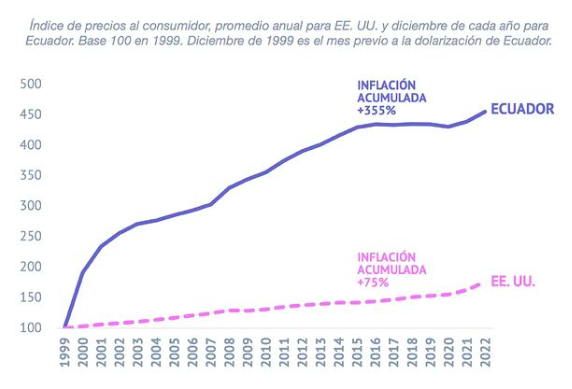By Leonard Quinde Allieri
(Opinion) A few months before the elections in Argentina, dollarization is the focus of the political debate.
Meanwhile, Ecuador could become a roadmap for understanding what it solves and doesn’t.
At the end of April, a graph on cumulative inflation in Ecuador, produced by the Latin American Strategic Center for Geopolitics (CELAG), generated some commotion in Argentina while dollarization is being debated.

Cristina Kirchner even used the publication to claim that dollarization would not curb inflation, citing an alleged 355% increase in Ecuador between 1999 and 2022, compared to a 75% increase in the United States, even though they use the same currency.
First, it is critical to clarify that Argentina’s cumulative inflation during the same period (1999-2022) was 27,356%, which should be the focus of attention.
Even if Cristina’s statement was correct – although it is not – the most relevant comparison for Argentina is not with the United States but with a dollarized economy such as Ecuador.
To put it in perspective, it should be remembered that Argentina has had that level of inflation not in 23 years but in the five years from 2017 to 2022, when Argentina experienced cumulative inflation close to 300%.
The priority should be, therefore, the study and analysis of this worrying economic reality.
But that 355% in Ecuador is misleading.
The graph includes the entire year of 1999 when Ecuador was not yet dollarized.
That year, Ecuadorians suffered a financial and inflationary crisis, leading us to repudiate the national currency.
In 2000 the dollarization was decreed, but as you must have guessed, this was not an automatic process.
A gradual currency exchange process lasted over a year, so the accumulated inflation between 1999 and 2000 was around 150%.
That is to say, almost half of the accumulated inflation that Cristina attributes to dollarization was without actually being dollarized.
In the same way that dollarizing Ecuador was not an automatic process, neither was the reduction of inflation.
First, we went through a process of inflationary deceleration; that is, it is not that we stopped having inflation, but we did see how it was decreasing year by year.
In 2001, we reached an inflation rate of 37.7%; in 2002, it dropped to 12.5%; in 2003, to 7.9% and in 2004, for the first time, we had the same inflation rate as the United States, reaching 2.7% that year.
Since then, Ecuador has never again had inflationary outbursts and has not surpassed the double-digit barrier.
Our highest inflation was during the administration of Chavista Rafael Correa, an international ally of Cristina Kirchner and a proud member of 21st-century socialism.
Under that government, we reached 8%, but once it ended, our inflation became even lower than that of the United States.
Moreover, if we analyze the accumulated inflation since 2004, Ecuador’s was 53%, and that of the United States was 47%.
Not even the inflationary “crisis” in the United States at this time has affected us; while in 2022, inflation in the United States was 8%, ours was around 3%.
Indeed, Ecuador is still a relatively poor country, but no one is saying that dollarization is a solution.
However, since dollarization, there has been an incredible explosion of wealth creation, a phenomenon that unfortunately was wasted because the Correa government discouraged private initiative, squandered resources, raised taxes and tariffs, and created trade barriers.
Consequently, in 2014, Ecuador faced an economic debacle again -for the first time- since the decision to dollarize was taken.
It would be illusory to believe that dollarization solves all problems.
No. It solves only one: inflation.
News Argentina, English news Argentina, Argentine economy, dollarization

